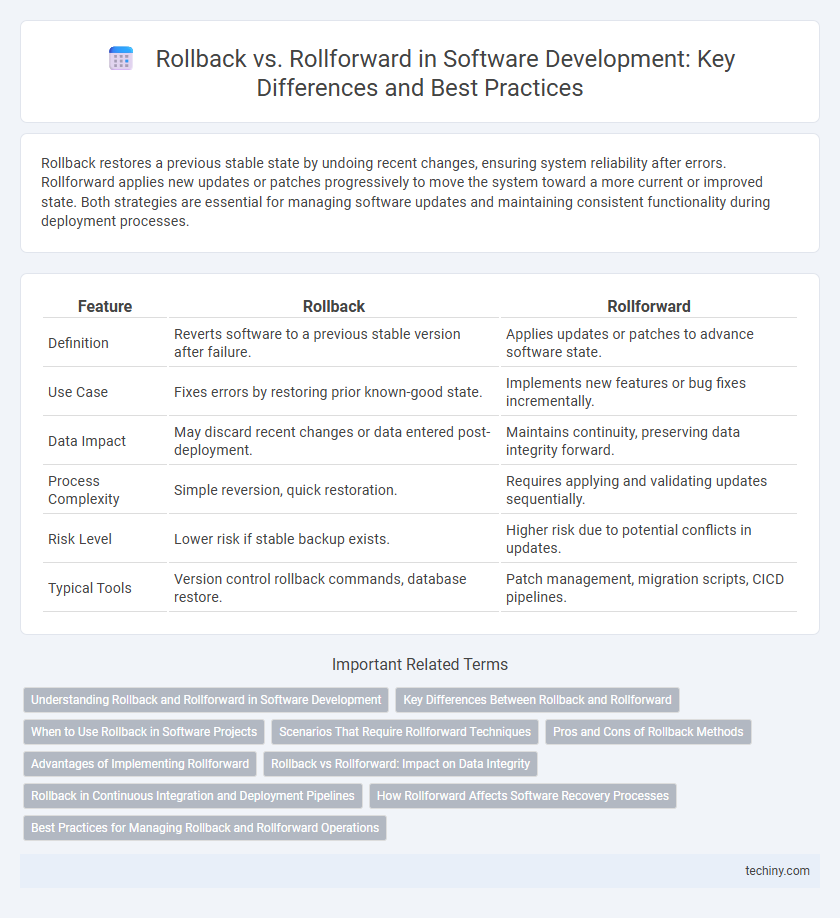Rollback restores a previous stable state by undoing recent changes, ensuring system reliability after errors. Rollforward applies new updates or patches progressively to move the system toward a more current or improved state. Both strategies are essential for managing software updates and maintaining consistent functionality during deployment processes.
Table of Comparison
| Feature | Rollback | Rollforward |
|---|---|---|
| Definition | Reverts software to a previous stable version after failure. | Applies updates or patches to advance software state. |
| Use Case | Fixes errors by restoring prior known-good state. | Implements new features or bug fixes incrementally. |
| Data Impact | May discard recent changes or data entered post-deployment. | Maintains continuity, preserving data integrity forward. |
| Process Complexity | Simple reversion, quick restoration. | Requires applying and validating updates sequentially. |
| Risk Level | Lower risk if stable backup exists. | Higher risk due to potential conflicts in updates. |
| Typical Tools | Version control rollback commands, database restore. | Patch management, migration scripts, CICD pipelines. |
Understanding Rollback and Rollforward in Software Development
Rollback in software development refers to reverting a system or application to a previous stable state after a failed deployment or error, ensuring minimal disruption and data integrity. Rollforward involves progressing forward by applying updates or patches to fix issues without reverting to an earlier version, often used when rollback is impractical. Both techniques are critical for maintaining system stability, managing risks, and supporting continuous deployment workflows.
Key Differences Between Rollback and Rollforward
Rollback reverts a software system to a previous stable state by undoing recent changes or updates, minimizing data loss during errors or failures. Rollforward applies committed transactions or changes from a backup forward to a newer state, ensuring data consistency and recovery after system crashes. Key differences include rollback's focus on undoing actions versus rollforward's role in reapplying changes to reach a desired system state.
When to Use Rollback in Software Projects
Rollback is essential in software projects when recent changes introduce bugs, errors, or system instability, allowing a return to a stable previous version. It is particularly useful after failed deployments, integration issues, or when immediate restoration of functionality is critical. Rollback ensures minimal disruption to users and maintains system reliability by reverting to a verified, error-free state.
Scenarios That Require Rollforward Techniques
Rollforward techniques are essential in scenarios involving database recovery after a system crash where transaction logs are intact, enabling the application of committed transactions to restore the database to its most recent consistent state. They are also crucial when partial failures occur, such as network disruptions during distributed transactions, requiring the reapplication of operations to maintain data integrity. Rollforward ensures minimal data loss by leveraging incremental backups and transaction logs, which is vital for maintaining high availability in mission-critical software systems.
Pros and Cons of Rollback Methods
Rollback methods in software development offer the advantage of quickly restoring systems to a previous stable state after a failed deployment, minimizing downtime and reducing potential data corruption. However, rollbacks can lead to data inconsistency if changes made after the rollback point are not properly managed, and they may require complex reconciliation processes to ensure system integrity. Despite these challenges, rollbacks remain a critical tool for mitigating risks during continuous integration and deployment cycles.
Advantages of Implementing Rollforward
Implementing rollforward in software development offers the advantage of faster recovery times by applying incremental changes to reach the desired state, minimizing downtime. This approach ensures data consistency and integrity by progressing through sequential updates, reducing the risk of data loss compared to rollback methods. Rollforward also simplifies error correction by allowing developers to move forward systematically rather than reverting to potentially outdated system states.
Rollback vs Rollforward: Impact on Data Integrity
Rollback restores a database or system to a previous stable state by undoing recent changes, effectively protecting data integrity from corruption or errors. Rollforward applies a series of changes or transaction logs to recover data and maintain integrity after a failure, ensuring updates are retained without loss. Both methods are critical for preserving data accuracy, with rollback preventing faulty updates and rollforward enabling progressive recovery.
Rollback in Continuous Integration and Deployment Pipelines
Rollback in Continuous Integration and Deployment pipelines is a critical process that reverses the software to a previous stable state after detecting issues in a new release. It ensures system reliability by quickly eliminating faulty deployments, minimizing downtime and customer impact. Automating rollback through pipeline scripts enhances recovery speed and supports continuous delivery best practices.
How Rollforward Affects Software Recovery Processes
Rollforward enhances software recovery processes by applying transaction logs or incremental backups to restore a system to its most recent consistent state, reducing data loss compared to rollback methods. This approach minimizes downtime by allowing systems to recover past the last full backup through replaying committed changes. Efficient rollforward mechanisms improve fault tolerance and ensure continuity in software development environments managing frequent or complex transactions.
Best Practices for Managing Rollback and Rollforward Operations
Effective management of rollback and rollforward operations in software development requires implementing automated version control systems and maintaining comprehensive backup strategies. Ensuring thorough testing and validation of patches before deployment minimizes the risk of failures that necessitate rollbacks. Detailed documentation and clear communication protocols enhance coordination among development teams during rollback or rollforward procedures, reducing downtime and data loss.
Rollback vs Rollforward Infographic

 techiny.com
techiny.com